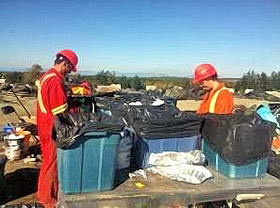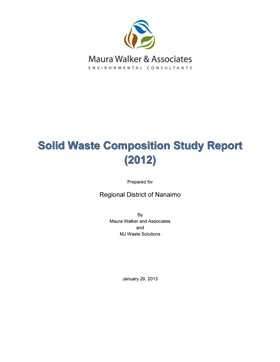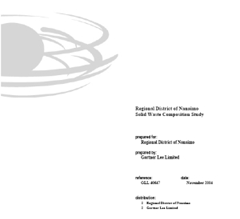RDN Waste Composition Studies
|
In 2012, the Regional District of Nanaimo (RDN) commissioned a follow-up to its 2004 study of the composition of waste being landfilled in the Region. Completed over five days in October at the Regional Landfill and Church Road Transfer Station, the 2012 Waste Composition Study provides important baseline information on the present nature of the solid waste stream and its changes over the past eight years.
The 2004 Waste Composition Study guided the development of Zero Waste programs and policies resulting from the 2005 Solid Waste Management Plan. The study identified compostable organics (food waste and compostable paper) and construction/demolition waste as the largest components of waste by weight being landfilled. These materials were targeted for diversion from the landfill through residential food waste collection (the Green Bin Program), and disposal bans on Commercial Food Waste and Clean Wood Waste. The 2012 Waste Composition Study is a key tool in the current process to update and review the region's Solid Waste Management Plan (SWMP). The study's findings have been used to assess the effectiveness of Zero Waste programs in diverting landfill waste and opportunities for improvement. Objectives of the 2012 Waste Composition Study
2012 Waste Composition Study: Key FindingsIn 2012 the annual rate of waste landfilled in the region was 350 kg per capita compared with 450 kg per capita in 2005. By participating in programs such as the green bin and commercial food waste diversion, residents, businesses and institutions have achieved one of the lowest per capita disposal rates in Canada.
 Per Capita Waste Landfilled in Kilograms: 2004 Vs 2012
Per Capita Waste Landfilled in Kilograms: 2004 Vs 2012
As the chart above illustrates, significant progress has been made by diverting wastes from the landfill, which were targeted in the 2004 SWMP. Compostable Organics (food waste and compostable paper) have decreased by 31 per cent and Building Materials (construction/demolition waste) have decreased by 19 per cent compared with 2004 levels. The 2012 Waste Composition Study determined that as much as 35 per cent of waste currently being landfilled could be composted and 20 per cent could be recycled. By emphasizing existing waste diversion programs, improvements could be realized in the following sectors:
|
 Waste sorters separate materials at the Regional Landfill for the 2012 Waste Composition Study.
Waste sorters separate materials at the Regional Landfill for the 2012 Waste Composition Study.
|


